Text
2013 Chateau Des Rontets Pouilly-Fuisse
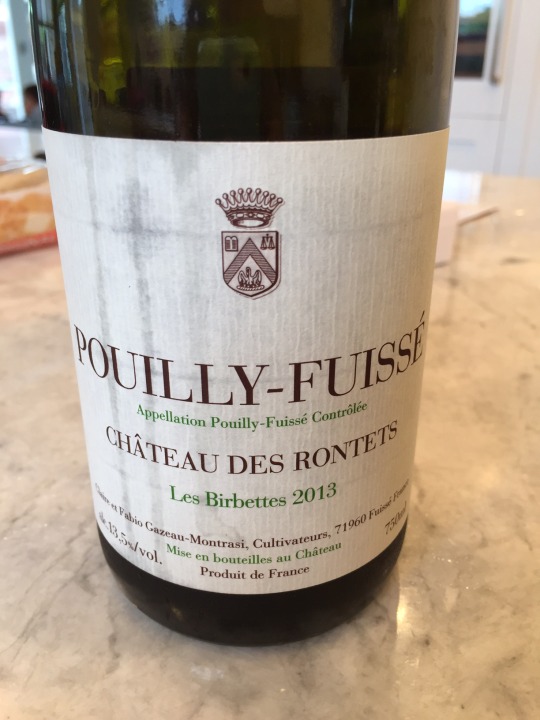
Ok, since it’s been awhile and this bottle has a pretty long name, let’s break down what’s going on here.
Many Americans are familiar with US and other new world wines being labeled based primarily on the producer (e.g. Robert Mondavi) and the grape varietal (e.g. Cabernet Sauvignon). There often is information about the region (e.g. Napa Valley) and in some cases even a specific vineyard (e.g. To Kalon). Occasionally additional information is on the label such as a positioning description for the wine (e.g. “reserve”) or a creative name for the specific bottling. Oh, and let’s not forget the vintage (e.g. 2001).
Ok, that’s upwards of 7 variables to track, though most labels usually have no more than 5. While this seems like a lot, if you look around you’ll find many other consumer products with a similar depth of variables. For example, consider a mobile phone purchase. It has a producer (e.g. ���Apple"), a specific model (e.g. “iPhone 7 Plus”), a color (e.g. black), a carrier (e.g. AT&T), and memory capacity (e.g. 128 GB).
Ok, no problem, right? You got this. So now let’s head to France and check out this Pouilly-Fuisse.
French labels include most of the same information an American label has. In this case the producer is Chateau Des Rontets, the region is Pouilly-Fuisse, the vineyard or this unique bottling would appear to be Les Birbettes (ok, I’m not entirely sure here!), and the vintage is 2013. Cool. But wait…where’s the grape varietal? For example, how do you know whether this is Sauvignon Blanc or Chardonnay?
This is the key difference in the labels. French wines, like most old world wines, do not often list the grape varietal. This is because wines made in a particular geographical area (in France called an Appellation d’origine controlee) usually can only be made with specific varietals. For this particular bottle, it’s from Pouilly-Fuisse in Burgundy and so must be Chardonnay because the producer wouldn’t be allowed to use the appellation name with another grape varietal.
So does this mean you need to memorize which grapes are associated with a bunch of regions? Unfortunately, this is more or less what you need to do, though there is general consistency within a broader region. For example, virtually all white wines from Burgundy are Chardonnay and all red wines are Pinot Noir.
Honestly, I think the new world approach makes more sense. While you might familiarize yourself with French appellations, what about Italy? What about Spain? It can be a lot to remember.
Ok, phew, now on to the wine.
First, the smell. I didn’t get much from this, though I have a slight cold so am not really qualified to make a judgement. (Why am I writing this? Well, I have a schedule to keep!) I did get a whiff of smoke. Now, in some extreme cases this can be considered a fault, but in this bottle it was a more nuanced and pleasing scent.
The first taste sensation that hit me was the acidity. As is common with white Burgundy, it has a more lively bite than a typical American Chardonnay. Refreshing!
I did say I had a slight cold, so I won’t comment further :O
Overall, this appears to be a well made, food friendly Chardonnay. Not something I’d jump to serve guests as an easy sipping cocktail wine, but defintely a nice pairing with foods, even fatty foods that you might otherwise pair with a Sauvignon Blanc. (One easy tip to remember is to consider serving a wine high in acidity with food that commonly benefits from a fresh squeeze of lemon on top - in both cases the acidity helps cut through the fat or complements the sweetness).
0 notes
Photo
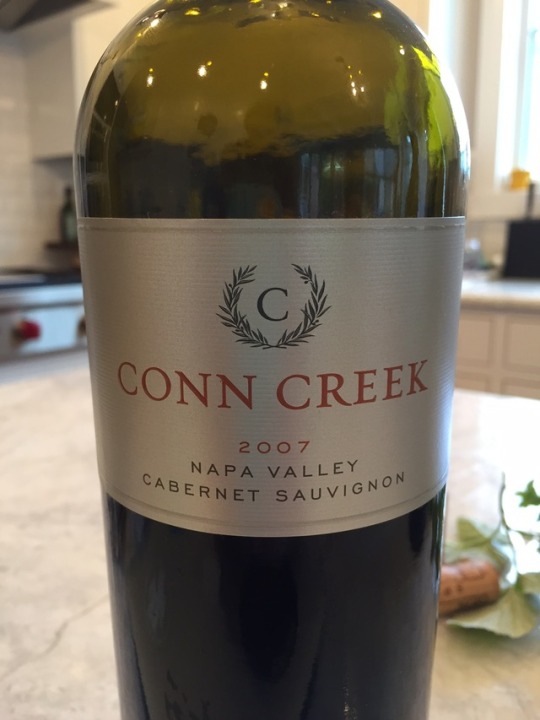
Years ago, I started writing a few thoughts in this blog on wines I drank to help force some learning. I’m not remotely close to being an expert; just someone with some curisoity about this unique beverage category.
I got a notice from tumblr recently which was a surprise. I had completely forgotten this blog ever existed. 5+ years of taking care of young children will do that to a person.
So, in the spirit of keeping a few side hobbies in-between work and changing diapers, I present to you my review of the Conn Creek 2007 Napa Valley Cab. It goes like this:
“Like this blog, I forget I owned these bottles but found them in storage last Friday. I like this wine. They didn’t cost much and deliver a wallop of a classic California cab experience! 2007 was a stellar year for Napa. A great proof point that you don’t need to pay ridiculous money to get solid quality wines, especially in good years!”
0 notes
Photo

2000 Chateau La Couspaude, St-Emilion
Bordeaux started out the new century with a killer vintage that Robert Parker claimed was "the greatest vintage Bordeaux has ever produced." Wow!
But that's not all -- Robert Parker and other famous critics have kept the 'vintage of a lifetime' hype going throughout the entire decade. The 2000s were the best, until 2005 of course. But now we have the 2009s, which, according to Parker, "may turn out to be the finest vintage [he has] ever tasted."
Perhaps. Or perhaps, like Don Corleone, as he ages he just likes to drink wine more than he used to. Anyways, Bordeaux has been on a run over the past decade. The best vintages keep getting better, and the high prices keep getting higher. Are we in a Bordeaux bubble? Or are these wines truly the best Bordeaux has ever been?
High quality Bordeaux typically needs a decade or more of aging to develop in the bottle before consumption. So while critics have claimed multiple times that Bordeaux had just had its 'vintage of the century', the true results are not quite in yet; for most drinker's palates, the great Bordeaux from 2000, 2005, and 2009 will only be entering their peak drinking windows between now and the next 20-30 years. It's not a sprint - it's a marathon.
So, to make a long story short, I've only recently started digging into the 2000s I have that appear ready to drink. Tonight's bottle - Chateau La Couspaude form St. Emilion - was ripe for the picking.
La Couspaude has a bit of a reputation for generous use of oak; the 2000 validated this with a wave of toasty oak aromas that leapt right out of the glass. The oak, however, framed a complex blend of dark fruit, cigar, and notes of coffee and cocoa through the finish. The tannins are fully integrated. The wine is absolutely in its drinking window and is very polished and elegant.
Are the Bordeaux 2000s like this La Couspaude better than the 2005s and 2009s? I'll enjoy figuring this out over the coming 20 years :)
4 notes
·
View notes
Photo

1982 Chateau Calon-Segur (St. Estephe)
My wife and I celebrated Valentine's day early this year so that we could secure reservations at one of our favorite restaurants. Perhaps not the most romantic approach, but practical considering we had our hearts (ok, not funny) set on a specific dinner course.
I selected the '82 Calon-Segur for the occasion based on its iconic label art that features a heart. Apparently despite owning Chateau Latour and Lafite -- both first-growth top ranked properties -- Nicolas-Alexandre, marquis de Segur said his "heart was with Calon."
Ok, I'm not sure where he was coming from, as I would happily trade my bottle of Calon for a Latour or Lafite any day. Furthermore, I'm also not clear on what a "marquis" is. But it doesn't matter; the important thing is that a pretty good Bordeaux is available with a heart logo that fits the Valentine day dinner requirements. I fully selected this book by the cover alone.
The wine's aroma and flavor are secondary to the label art in this context, so I won't bother reviewing it. My wife liked it, so it was a success. It's also hard to really screw up '82 Bordeaux.
2 notes
·
View notes
Photo
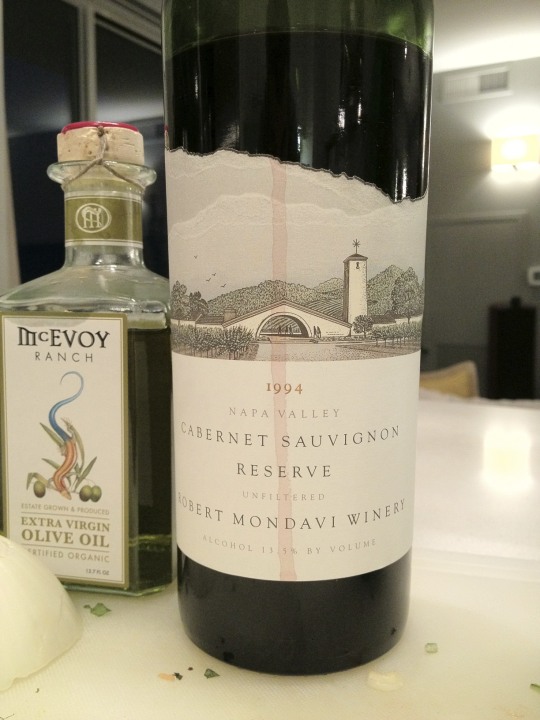
1994 Robert Mondavi Cabernet Sauvignon Reserve
The 90s were a special time for me; the decade encompassed the majority of my formal education and development from a youngster to a young adult. The 90s were also a special time for California; though the Judgement of Paris in '76 may have put the spotlight on California Cabs, Napa Valley's run of outstanding vintages from '91 to '98 gave it the runway it needed to firmly establish its quality reputation globally.
Hard to believe that the bottlings from the early part of the decade are now going on 20 years. (And hard to believe I have a 20 year high school reunion coming up!) It's an opportune time to be drinking high quality 90s era California Cabs!
Robert Mondavi Winery is legendary. Forget the cheap Coastal Estates and Woodbridge brands, the family drama, and the ultimate acquisition of the winery by Constellation in 2004. Robert Mondavi and his winery were instrumental in putting Napa Valley on the map. The man was a pioneering evangelist for the California wine industry and produced a wide range of outstanding wines over his lifetime. If you have an opportunity to taste a Mondavi Cab reserve (Mondavi's flagship wine), don't pass it up! Production volumes are high, but this doesn't detract from the quality in good vintages.
Robert Parker claimed "the 1994 Cabernet Sauvignon Reserve...may be the finest Cabernet ever from Mondavi." This, however, was back in '97 - the questions readers will want to answer is where the '94 stands today?
It has a solid nose (winespeak for aroma) of oak, ash, and some blackberry/cassis flavored cough syrup. Its color retains a classic deep crimson red in the center of the glass, but clearly shows some age with bricking at the edge. No longer in its youth, this wine has picked up some wrinkles and character. It has a great silky smooth mouthfeel - another sign this is not a Mondavi Cab in its younger days. Its fruit has now matured (and arguably faded a touch beyond desired) but still shows presence. A complex web of dark fruit and tobacco leaf layers keep this drink interesting.
Is it the greatest Mondavi of all time? Highly doubtful at this point - this wine is a touch past its prime. The '94, however, remains an outstanding wine and its elegant flavor profile after 18 years should make it very appealing not only for California Cab fans, but also Bordeaux purists.
Robert Mondavi is no longer with us. And his winery is now run by Constellation (though it still produces great wines!). Readers who are interested in following the Mondavi story should seek out Tim Mondavi's 'Continuum' wines.
#1994#Robert Mondavi Winery#Robert Mondavi#Napa Valley#Oakville#California#Cabernet Sauvignon#Reserve#Tim Mondavi#Continuum#Judgement of Paris
29 notes
·
View notes
Photo
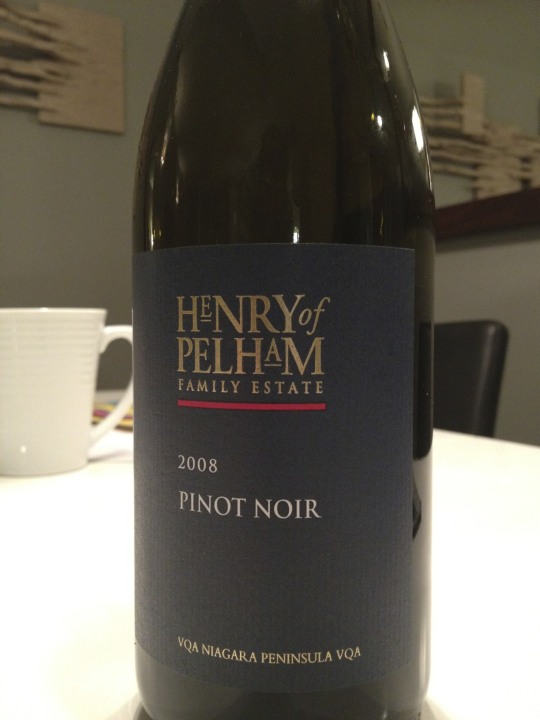
2008 Henry of Pelham Pinot Noir - Niagara Peninsula
The Niagara Peninsula, which runs along the South shore of Lake Ontario on the Canadian side, is home to many wineries and is reported by the Canadian Vintners Association to account for 80% of the nation's grape-growing volume. It features a cool climate (no shocker!) and is best known for icewines, a type of desert wine produced from grapes that literally have been frozen on the vine.
Henry of Pelham, the producer of this wine, was an early pioneer in the region dedicated to premium estate grown releases. I previously tried their Baco Noir but, sadly, was not a big fan. Regardless, I thought I should give this producer another shot.
This Pinot is light in color and, unfortunately, aroma. It's unlikely to win awards for its smell, though on a positive note nothing awkward jumped out of the glass. It offers spry, zingy berry flavors that echo characteristics of Pinot from better known regions but certainly represent, as the winery suggests, the 'authenticity' of the Niagara Peninsula terroir.
Do I recommend readers rush out and track this down? Nope. But for those curious about wines grown in this very cool climate, Henry of Pelham is a good go-to source given their long history and reputation producing premium wines in the region.
Wines from new regions (for me) can occasionally be a challenge; though I respect the technical winemaking, my palate was developed by tasting hundreds (ok, thousands) of bottles from more common wine regions of Europe and the U.S.
Given more exposure and tastings of wines from this region, it's quite possible I'd develop a stronger taste and appreciation for the local style. There's only one way to find out, so I'll be sure to rotate in some Niagara selections over time before drawing firm conclusions!
14 notes
·
View notes
Photo

2007 Leone de Castris Salice Salentino Riserva
Salice Salentino is a red wine composed of Negroamaro and Malvasia Nera varietals grown in Southern Italy. Italian speakers will recognize the words negro as "black" and amaro as "bitter." No surprise, therefore, that Salice Salentino wines are a dark color with a flavor profile that is typically considered rustic and a bit rough around the edges.
With the word "bitter" in its name, a $13 price tag, and a label that doesn't inspire my creative imagination, I had set low expectations for this bottle. Sure, this wine was a staff pick from my local wine merchant, but I was still suspicious this could have been a ploy to clear out some overstock run-of-the-mill swill.
Absolutely. Not. The. Case.
This Salice Salentino brings, as Gary V would say, the thunder. Rich and bold, it has gobs of black cherry, mineral, and smoke flavors that explode across the palate. Tons of structure, character, and complexity for a wine at this price. If I had paid 2-3x more for this, I still would call this out as a value buy - it clearly over delivers for a $13 bottle.
Drinking wine made from a grape formally named "bitter" may not sound appealing, but in the hands of the Leone de Castris winery this varietal sings! This is an absolute steal for the price and a wine worthy of stocking up by case. It will certainly age gracefully over the next decade so there will be plenty of opportunities to throw this down the hatch.
1 note
·
View note
Photo
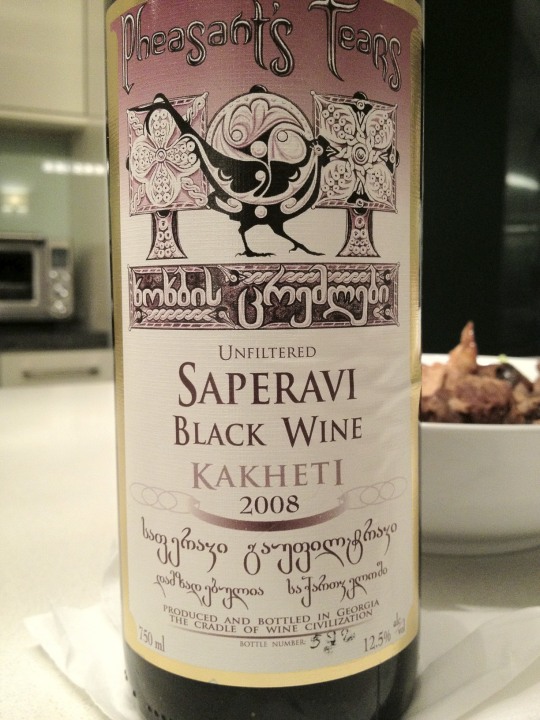
2008 Pheasant's Tears Saperavi Republic of Georgia
I'm always on the lookout for bottles from unusual places. So I was excited to try my first wine from Georgia. (For purposes of clarity, I'm referring to the country, not the U.S. state, which actually also produces a range of wines.)
As I was opening up the bottle, I noticed the label claimed Georgia was the "cradle of wine civilization."
And here I was thinking Georgian wine was an esoteric find; it turns out I'm just emerging from the cradle myself. Georgia is one of the oldest wine producing regions of the world with a culture of cultivating grapevines going back over 8,000 years. Ok, let me revise my initial sentence: I'm always on the lookout for under appreciated bottles of wine from old-school regions who brought the world wine culture from day one.
So what is this bottle all about? Saperavi is a varietal known for its intensive dark-red color -- so dark, in fact, that it's often referred to as black by locals. Saperavi is one of many varietals grown in Georgia, but is common for export wines as it's considered one of the better grapes.
This wine was dark, but closer to purple hues than black. Aromatically, it felt like I used a freshly sawn wooden shovel to scoop up a healthy portion of moist earth (probably with some worms) topped by dark stewed fruit syrup.
It is rich and fruit-forward, but with an interesting finish of dusty tannins and slowly fading minerals. If you're not an everyday Saperavi drinker (and let's face it, most of us aren't!), this wine requires an open mind. But with the right approach, I'm sure most readers will conclude there's a lot of wine here for <$20.
So readers please remember this - Georgia wines aren't "unusual." They actually are amongst the first wines every made. In the entire history of humankind.
So if you want to bring your evening back to basics, secure some Georgian fermented grape juice for the evening and party like it's 6000 BC.
1 note
·
View note
Photo
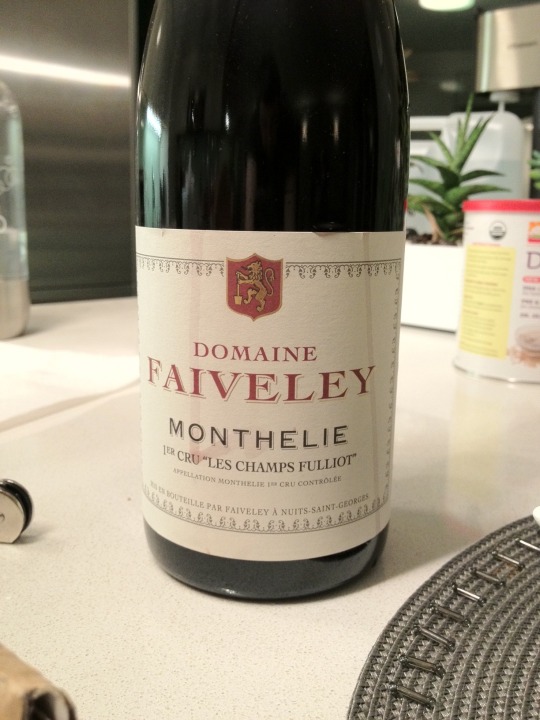
2009 Domaine Faiveley Monthelie 1er Cru "Les Champs Fulliots"
Recently Burgundy has been growing on me.
For some time, I've considered Burgundies pleasant but underwhelming next to the raw power and concentration of Bordeaux. Switching from a glass of Pauillac to a glass of Cote d'Or is like switching from a playlist of hyper-compressed French house music (think Justice or Daft Punk) to a playlist of classic jazz trios. The former turns the volume up to 11 with raw power and constant intensity; the latter presents a softer, relaxed experience that requires more of the listener's attention to hear and appreciate the complexity and details of the music.
I think I am finally getting Burgundy. To borrow from my music analogy, it generally has more dynamic range and complex arrangements that require more of the drinker; its message is quieter but for the those who will listen closely, the rewards are immense.
I've nursed this bottle of Monthelie over the past three days, constantly intrigued with its depth. On the first day, it presented a perfumed fruit-forward bouquet of red raspberry. On day two, it mellowed and delivered more earthly flavors. Finally, on day three it hit its stride completely and came up with a gorgeous nose of herbs with standout notes of rosemary. I wish I could look forward to day four, but with the bottle down to its final sips, it has run its course. I may be forced to cellar a few bottles for a decade to find out what "day four" is about.
Readers hooked on Robert Parker's loud pop band cranked to 11 need to approach wines like this with a different mindset. Burgundies need to be appreciated and evaluated for what they are. Just as one wouldn't review a classical symphony based on aesthetic paradigms of rock, one shouldn't grade Burgundy based on concepts like absolute power and intensity derived from Bordeaux.
Different circumstances call for different music and different wines. There is a time and place for most things, including the more delicate and subtle passages of life (OK, not everything - some things, and wines, just suck and/or are boring).
Get familiar with Burgundy, and rotate it in your playlist when the time is right :)
0 notes
Photo
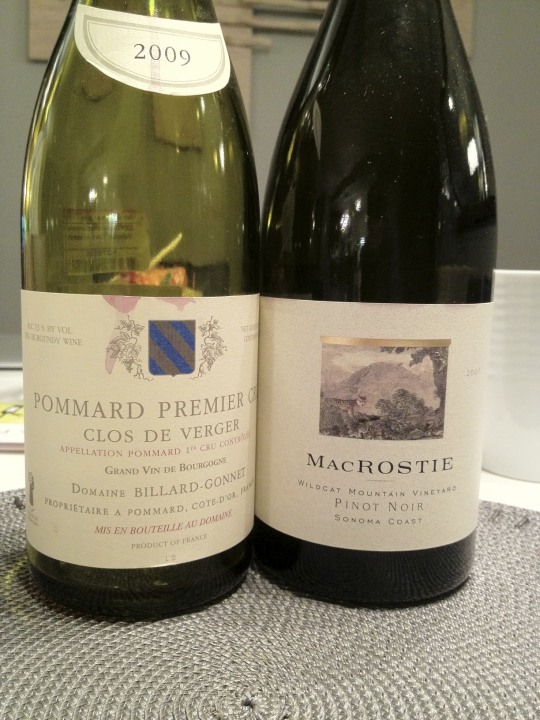
2009 Domaine Billard-Gonnet Pommard "Clos de Verger" x 2007 MacRostie "Wildcat Mountain Vineyard" Sonoma Coast Pinot Noir
My wife and I enjoy a good steak as much as the next person (vegetarians excepted!), but our typical daily fare is much lighter than a rib-eye -- plenty of vegetables, white meat (chicken/pork), and seafood. So though heavy blockbuster Bordeaux and California Cabs were the first wines I fell for, on many nights they simply do not make the best pairing option.
I've been meaning to drink more Pinot - "meaning" being the operative word here. My natural inclination is still to pull Cabs daily from the cellar like I pull socks out of the dresser. It takes some discipline to change behaviors, and so I've been making a conscious effort to dial back the power quotient on our wine selections a few notches to fit better with our meals.
I'm a few years into the wine (bad) habit, but still pretty new to the Pinot world. So I'm taking the shotgun approach; I often open two at the same time to compares and contrast, and also try the 2nd and 3rd day leftovers to get a sense of how they will age. This weekend I matched a well reviewed Californian with a well reviewed Burgundy to see who would emerge victorious.
The answer: well, it's a tough call, but probably neither (on their own). The Pommard brought the Burgundian earthy funk, but was a touch on the delicate side for my taste. The MacRostie came strong with California ripe fruit power and threw in some savory herbs and spices for good measure. Good stuff, but it lacked the elegance of the Pommard.
My solution? I mixed the two together, roughly 50/50. The result? 1+1=3. Yes dear readers, my entirely unorthodox approach resulted in the greater good for the evening - the best of Burgundy with the best of California, mixed together in a single glass. Saves time, saves energy, and brings the best of both worlds to you in a single sip!
I encourage folks to give wine 'mash-ups' a try; while single site vineyard releases are still the focus of wine drinkers (i.e. "taste the place"), mashing up two bottles often results in some good fun and interesting tastes. As Oscar Wilde noted, "life is too important to be taken seriously." And the same goes with wine...
#2007#2009#MacRostie#Wildcat Mountain Vineyard#Sonoma Coast#Pinot Noir#Burgundy#Pommard#California#France#Burgundy#Domaine Billard-Gonnet#Clos de Vergers#1er Cru
4 notes
·
View notes
Photo

1997 Langoa-Barton, Saint Julien
The Bordeaux '97 vintage hasn't won many accolades by critics, most of whom have concluded the wines are without sufficient concentration of fruit to be distinctive. There was plenty of rain in '97; while this may result in nice juicy table grapes, it's the last thing a vintner wants as it can result in diluted flavor in wines. Imagine what dousing a glass of water in an outstanding concentrated wine would do - enough said!
Off-vintages like '97 are also where value buyers like myself like to focus to seek out gems that sell at a discount to more heralded vintages. K&L in San Francisco, my go-to wine shop, hyped up the '97 Langoa-Barton as a top value. Granted, bottles were being sold for $40, hardly a price point considered 'value' to many folks; however, considering the 2005 retails for $90, it's a good deal for a quality Bordeaux with 15 years of age under its belt.
I think K&L made a great recommendation here. The '97 Langoa-Barton, a blend of primarily Cabernet Sauvignon and Merlot, features a gorgeous nose (wine-speak for aroma) of leather, herbs, and sweet oak. It doesn't have the rich concentration of fruit found in better vintages, but it has enough to hold the wine together. Well into its teens, the tannins are now fine and smooth bringing an elegant feel. Overall, a very balanced mature Bordeaux.
In the mood for a Bordeaux but feel the balance and weight of a Pinot would be more appropriate for your meal? In this scenario this wine really shines!
I highly recommend this wine for readers interested in trying a mature quality Bordeaux on a budget. This wine delivers classic aged Bordeaux flavors for less than $50! You'll miss out on the intense fruit concentration and long finishes found in better vintages and wines, but you'll also save yourself a ton of money! (And keep in mind for some meals this wine will even pair better!)
[Note: Sadly, this wine does not seem to be widely available anymore; keep your eye out for this!]
#1997#Langoa-Barton#Saint Julien#Bordeaux#France#Cabernet Sauvignon#Merlot#Cabernet Franc#Petit Verdot
1 note
·
View note
Photo

2005 Guy Drew Vineyards Meritage, Cortez, Colorado
Colorado makes wine?! You bet, the state is home to dozens of wineries! Colorado gets tons of sunshine, has a dry climate, and features diverse mountainous geography. Why wouldn't adventurous vintners give it a try?
Despite that introduction, this was the first time I got a chance to try a Colorado wine as I was transferring through the Denver airport. The airport bar's wine list had this to say about this selection: "rich, velvet, bright fruit, balanced acidity and integrated tannins."
I agree that it's rich -- extremely rich with chunky, austere mouth drying dusty tannins. The nose features bright fruit but also some heat from the alcohol. The wine was aged in used and new French oak, and it shows. This bordeaux style blend is intense, rustic and, given its geographic source, an interesting effort. With its concentrated flavor and intense tannins, this would be better with some additional aging - perhaps another 5-10 years.
The retail price according to the Guy Drew website is $19, a reasonable price to pay for a wine that sees a few years of oak aging before release. I don't see Colorado wines distributed often (at least outside Colorado!), so curious drinkers will probably need to order direct from the winery.
I'll stop short of recommending readers seek this out, but I do encourage folks to keep trying new wines, and if you haven't tried a bottle from Colorado it's time to hunt one down!
[Note: I tasted this wine by the glass from a wine bar; it is possible that it had been open for a few days before tasting]
#2005#Guy Drew#Meritage#Cortez#Colorado#United States#Bordeaux blent#Cabernet Sauvignon#Cabernet Franc#Petit Verdot#Lounge 5280
6 notes
·
View notes
Photo

2007 Gloria Ferrer Carneros Pinot Noir
Gloria Ferrer is most well known for its Champagne-style sparkling wines. The two primary varietals used in these wines are Pinot Noir and Chardonnay. Most productions are blends but in isolation Pinot offerings are called 'Blanc de noirs' and Chardonnay offerings are called 'Blanc de blancs.'
I somewhat disgress, though, as this bottling is not a sparkling wine. I imagine as the wine makers at Ferrer were perfecting their Pinot and Chardonnay vineyards years ago, at some point they surely thought to themselves "hey, since not all wine drinkers go for bubbly, we could expand our market by leveraging our great fruit to make some still wine as well." And that brings us to today's selection - a classic still Pinot Noir red.
Readers here know that I'm always on the lookout for value priced (<$20) quality Pinot, so this selection, priced at $15 retail, attracted my attention.
It is a very balanced wine with excellent strawberry and red fruit characteristics matched with some good complexity -- not any extreme barnyard manure funk, but a touch of, to borrow a term from yesterday's post, earthiness. It's tart acidity (common for cooler growing regions like Carneros) makes it an extremely food-friendly wine. And its finish lingers in the mouth longer than most Pinots at this price point.
I'm extremely impressed with this effort. If Gloria Ferrer keeps releasing Pinot like this for <$20, it will become as well known for its still wine as its traditional sparkling product line. Bravo!
25 notes
·
View notes
Photo

2005 Beringer Cabernet Sauvignon Marston Ranch Napa Valley
Beringer is a very large winery that produces everything from <$10 value wines you can find at the supermarket to ultra-premium >$100 wines that compete with the best cult classics Napa has to offer. Founded in 1875, this winery has seen a lot of action in its day - including survival through Prohibition! Beringer may not be the trendiest winery in Napa, but it is a landmark producer with a rich history (and one of the more charming large wineries to visit)!
The 2005 Marston Ranch is one of Beringer's premium single vineyard offerings from a vineyard a few miles from its original estate. It is not widely distributed, so interested drinkers may need to search around to find a bottle. But before they do, let's review what this has to offer.
Inky purple, this wine has good concentration with a nose of currant, blackberry, and oak. It is full bodied, with chewy tannins and good complexity delivering some earthy flavors. All in all, a solid effort that screams California.
Before anyone goes off on a treasure hunt tracking a bottle down, however, let me pass on my advice - skip this '05 and throw in a few extra dollars to get the outstanding 2007 Private Reserve! I tasted through a wide range of vintages at a recent visit to the winery, and the '07 was the standout and is worthy of the high scores it has received.
3 notes
·
View notes
Photo

2008 Red Tail Ridge "Martini Family Vineyard" Finger Lakes Lemberger
Tired of Cabs, Merlots, Pinots, and Shiraz? Feel like you've 'been there, done that' every time you pass by the wine section at the local supermarket? Why not go out of your way to get a bottle of Lemberger to enjoy at dinner? Never heard of it? How about Blaufrankisch? Not that either? Well, join the club.
This wine hails from Upstate New York, a region that seems to be on the rise with over 100 wineries and vineyards. Most drinkers have probably never tried a Finger Lakes wine, and certainly not a glass of Lemberger!
This was my first experience with the Lemberger/Blaufrankisch varietal. The initial smell of this wine was 100% plastic saran wrap. Yes, you "can count on Saran For Freshness That's Easy" but that's not a tag line that I want to come to mind when sniffing a newly opened bottle of wine. I had a mixed reaction of "wtf?!?" and intrigue at how the winemaker created such a concoction...
After a few minutes, the plastic wrap aromas seemed to blow off and left a lighter style acidic red in my glass defined by notes of spicy pepper.
At this point, you may be expecting me to trash this wine; in the end, however, it turned out to be a highly-drinkable juicy red for the evening. Not sure I'll be stocking too much Lemberger in my cellar, but it was a breath of fresh air from the usual!
4 notes
·
View notes
Photo

2006 Descendientes de Jose Palacios "Petalos del Bierzo" Bierzo
Take a blueberry pie, warm it over a long period of time with exotic spices, and drain the remains into a bottle. Slap some attractive label art on it and, voila, you have the 2006 Petalos.
14 notes
·
View notes
Photo

2009 Comte Louis de Clermont-Tonnerre "Cuvee Julie" Chateauneuf-du-Pape
$20 Chateauneuf-du-Pape from a good vintage? Count me in!
Chateauneuf-du-Pape is part of France's Southern Rhone region. Though appleation regulations permit thirteen different varieties of grapes, this blend sticks with two popular ones: Grenache and Syrah. Rhone wines are often the third category of French wine drinkers explore after Bordeaux and Burgundy; this is largely due to the 'brand' of the region and not quality. Rhone wines are distinct but can compete in quality with the best of Bordeaux and Burgundy.
This effort is outstanding for $20! Bursting with full berry flavors, it also contains nuances of pepper and herbs common to the region. Though many Chateauneuf-du-Pape's are built for cellaring, this is a lighter style that is drinking beautifully right now! I've read reviews suggesting this could be aged for years to come, but suspect this wine's best years ahead are limited to single digits. No, this isn't the most concentrated and complex offering from 2009 - but for a single $20 bill it should bring joy to your home! (as a good wine should!)
Never tried a Chateauneuf-du-Pape? This is an outstanding and accessible candidate, both in terms of price & taste, for your hard earned twenty. Good luck finding a bottle!
16 notes
·
View notes